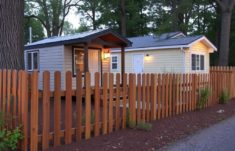Fences for Tiny House Communities: Creating Boundaries Without Sacrificing Charm
When it comes to tiny house communities, fences play a crucial role in defining personal space, enhancing security, and contributing to the overall aesthetic of the neighborhood. Unlike traditional residential areas, tiny house communities have unique needs and challenges that call for thoughtful fencing solutions. Whether it’s about maintaining privacy, establishing a sense of ownership over a compact lot, or fostering community interaction, fences help balance these aspects beautifully. If you are considering how to approach fences for tiny house communities, this article will guide you through everything you need to know, from the types of materials and designs to regulations and best practices.
- Why Fences Matter in Tiny House Communities
- The Role of Fences in Defining Boundaries
- Enhancing Community Interaction Versus Privacy
- Choosing the Right Fence Material for Tiny House Communities
- Wood Fences: Classic and Cozy
- Metal Fences: Sleek and Modern
- Fencing Styles and Designs That Suit Tiny House Communities
- Creative Fence Ideas to Maximize Space
- Legal Considerations and Regulations
- Maintaining and Caring for Your Fence in a Tiny House Community
- The Social Impact of Fences in Tiny House Communities
- Community Guidelines for Fences
- Budgeting for Your Fence in a Tiny House Community
- Innovative Fencing Trends for Tiny House Communities
- Case Study: A Fence Transformation in a Tiny Home Village
- DIY Fence Ideas for Tiny House Residents
Why Fences Matter in Tiny House Communities

In traditional neighborhoods, fences often serve as straightforward barriers to mark property lines or add security. However, for tiny house communities, fences assume additional importance. The small footprints of these homes mean outdoor spaces are limited but immensely valuable. A well-designed fence creates a personal retreat, offering privacy from neighbors while still allowing for connection and community spirit.
One of the main challenges is avoiding fences that block natural light or make the space feel cramped. Instead, fences in tiny house communities should enhance the character of the homes and surroundings. They can help reduce noise, shield outdoor living spaces, or simply provide a beautiful frame to the tiny abode’s garden or porch area.
The Role of Fences in Defining Boundaries
Because tiny houses are often placed close together, defining your lot boundaries is essential. Fences serve as a subtle yet effective way to establish where your space begins and ends without the need for invasive walls or oversized barriers. This can promote respect among neighbors and help avoid disputes over property lines.
Enhancing Community Interaction Versus Privacy
Tiny house communities often emphasize social connections and shared experiences. However, the desire for privacy remains. The right fence strikes a balance — open designs like latticework or picket fences can encourage friendly waves and conversations, while taller, denser fences offer quiet, secluded spaces for reflection.
Choosing the Right Fence Material for Tiny House Communities

Picking the ideal fence material involves several considerations: durability, maintenance, cost, style, and how the fence complements the tiny home environment. Here’s a closer look at commonly used materials and their suitability:
| Material | Pros | Cons | Best For |
|---|---|---|---|
| Wood | Natural look, versatile styles, easy to customize | Prone to rot, requires regular maintenance | Traditional, rustic, or cottage-style tiny houses |
| Metal (Aluminum, Steel) | Durable, low maintenance, modern appearance | Can be expensive, may feel industrial | Contemporary tiny homes, sleek aesthetics |
| Vinyl | Low maintenance, weather resistant, available in many styles | Less environmentally friendly, can crack in cold weather | Cost-effective fencing with minimal upkeep |
| Bamboo | Eco-friendly, lightweight, unique look | Less durable, requires treatment to last | Eco-conscious tiny house communities |
| Chain Link | Inexpensive, secure, easy to install | Poor privacy, industrial look | Security-focused areas or dog enclosures |
Wood Fences: Classic and Cozy
Wood remains the most popular choice in tiny house communities, largely because it adds warmth and charm. From picket fences to horizontal slats, wood fences fit wonderfully with most tiny home designs. If you’re looking to maintain a natural aesthetic and customize your enclosure’s height, color, and texture, wood offers almost unlimited options. Keep in mind the need for ongoing care such as painting, staining, or sealing to protect against weathering.
Metal Fences: Sleek and Modern
Metal fencing materials like aluminum or steel bring durability and a distinctly modern edge. They are great for tiny home owners who want minimal upkeep and streamlined designs. Powder-coated metal fences add color and rust resistance while maintaining an airy, open feel, which works well when you don’t want space to feel closed in.
Fencing Styles and Designs That Suit Tiny House Communities

Fencing style dramatically influences both the privacy level and visual impact of your lot boundary. Here are some popular options that work perfectly for tiny house setups:
- Picket Fences: Classic and inviting, picket fences provide boundary definition without feeling imposing. Ideal for front yard visual appeal.
- Horizontal Slats: Contemporary and sleek, horizontal wood slats create a sense of openness while offering privacy.
- Lattice Fencing: Great for climbing plants, lattice fences blend in with nature and maintain light flow.
- Living Fences: Using hedges or shrubs as natural barriers brings greenery wherever space is tight.
- Split Rail: Rustic and minimal, these fences are more symbolic boundaries than barriers and fit well with rural-style tiny house communities.
Creative Fence Ideas to Maximize Space
Given the constraints within tiny house communities, some owners think beyond typical fence panels. For example, modular fence panels on wheels can create temporary boundaries that can be repositioned seasonally. Combining fences with vertical gardens not only maximizes privacy but also enhances your green space and produces a calming, cozy atmosphere.
Legal Considerations and Regulations
Before building any fence in a tiny house community, it’s critical to understand the local zoning laws and community covenants. Many tiny house neighborhoods have specific guidelines to maintain consistency, protect views, or ensure fire safety. Here are some common points to explore:
- Maximum fence height restrictions: Often fences cannot exceed 6 feet in height, but some communities limit them to lower for better sightlines.
- Permits: Some jurisdictions require a building permit before installation.
- Material regulations: Fire-prone areas might disallow wood fences or require treated materials.
- Boundary setbacks: Fences might need to be placed a certain distance away from sidewalks or street edges.
Always liaise with your tiny house community association or local government to avoid potential conflicts or fines.
Maintaining and Caring for Your Fence in a Tiny House Community
Because tiny house owners often emphasize sustainability and economy, maintaining fences efficiently is essential. Here are some practical maintenance tips:
- Wood fences: Apply sealants every 2-3 years to prevent rot and insect damage. Inspect regularly for loose boards or nails.
- Metal fences: Check for rust spots and touch up paint as needed. Keep plants away to avoid corrosion issues.
- Vinyl fences: Clean with mild detergent and water to prevent staining or mildew buildup.
- Bamboo fences: Treat with preservatives yearly to protect against moisture and insects.
Seasonal maintenance not only extends fence life but keeps your tiny home community looking its best and fosters neighborly pride.
The Social Impact of Fences in Tiny House Communities
Beyond physical barriers, fences carry a social message in tight-knit environments. Open, low fences invite conversations and connections, helping build a supportive atmosphere that many tiny house residents value. On the other hand, some people need more solitude, especially when working from home or caring for family members.
Opting for fencing that can be adapted—such as fences with gates opening into shared yard spaces—can give residents a choice between socializing and privacy. This flexible approach respects diversity within the community and helps everyone feel comfortable in their small yet meaningful space.
Community Guidelines for Fences
Many tiny house communities establish guidelines or “fencing etiquette” that include:
- Allowing certain fence heights for backyard areas but limiting front yard enclosures
- Encouraging natural or neutral fence colors
- Promoting eco-friendly materials and designs
- Discouraging intrusive fences that block neighbors’ light or views
These guidelines create harmony and protect the unique spirit of tiny house living.
Budgeting for Your Fence in a Tiny House Community
Cost is always a consideration when investing in fencing. Here’s a general idea of typical fencing costs per linear foot to help you plan:
| Fence Material | Average Cost per Linear Foot | Installation Considerations |
|---|---|---|
| Wood | $15 – $30 | DIY possible but professional installation recommended for durability |
| Metal (Aluminum, Steel) | $25 – $50 | Usually requires professional installation |
| Vinyl | $20 – $40 | Moderate installation complexity |
| Bamboo | $10 – $25 | DIY friendly but may need periodic replacement |
| Chain Link | $7 – $15 | Quick, easy installation |
Remember to budget not only for materials and installation but also for maintenance. A more expensive fence now could save you money in repairs and upkeep later.
Innovative Fencing Trends for Tiny House Communities
Designers and community planners continue to experiment with fencing innovations that fit tiny house living, such as:
- Multi-functional fences: Incorporating shelving, seating, or planters within the fence structure.
- Wireless security fences: Combining fencing with smart sensors and lighting.
- Recycled materials: Using pallets, reclaimed wood, or composite materials to reduce environmental impact.
- Temporary or seasonal fences: Allowing spaces to open up during warmer months and close off for winter privacy.
These creative options emphasize the versatility and community spirit underpinning tiny house neighborhoods.
Case Study: A Fence Transformation in a Tiny Home Village
In a well-known tiny house community in Oregon, residents replaced their traditional chain-link fences with living hedges combined with low wooden slats. This change not only improved privacy but also introduced more wildlife and greenery into the neighborhood. The project was a community effort, blending social engagement with functional design, and it beautifully demonstrated how fences can be part of the lifestyle—not just an afterthought.
DIY Fence Ideas for Tiny House Residents
For those who want a hands-on approach, here are some quick, do-it-yourself fence ideas tailored for small spaces:
- Reclaimed pallet fencing: Affordable, rustic appearance, easy to assemble and customize.
- Trellis with climbing plants: Adds privacy and greenery without heavy structures.
- Decorative screens: Lightweight panels made from metal or wood, easy to move and rearrange.
- Vertical garden fences: Combining greenery and fencing to maximize space and privacy.
DIY projects can also foster a deeper connection to your home and community, making small spaces feel even more personal and inviting.
Conclusion
Fences for tiny house communities are more than just utilitarian constructs; they’re an opportunity to blend practicality with creativity, enhancing both personal space and communal harmony. Selecting the right fence involves understanding the unique needs of compact living—balancing privacy with openness, sustainability with durability, and aesthetics with affordability. Whether opting for cozy wooden pickets, sleek metal slats, or innovative living fences, the right fence can transform your tiny home environment into a welcoming sanctuary. With thoughtful design and an awareness of regulations, fences in tiny house communities don’t just mark boundaries—they help define a lifestyle rooted in mindful living, connection, and beauty. Whether you’re building, renovating, or simply dreaming, the fence you choose will shape how you live and relate to your tiny house neighbors for years to come.







